Jane Goodall and Affordable Housing
I recently joined some 200 business executives, social entrepreneurs and investors from Canada to the tip of Chile attending the Americas Business Council (abc*) Foundation’s 2011 Continuity Forum. The abc* Foundation is a “think-do tank,” whose co-founders are some of the most successful corporate leaders from Latin America, heading up companies playing major roles in business, media, agriculture, food sciences and health, energy, banking and finance. They have a strong sense of purpose, using their leadership, resources and networks to help further peace, sustainability and prosperity by supporting impact-driven tangible solutions. This Forum intended to call attention to major economic and social challenges and opportunities in the Americas, showcase leading innovative solutions developed by Ashoka Fellows in the region, and award three of the 34 finalists with a year of mentoring and connections to grow their innovations to scale.
I spotted Francesco Piazzesi, founder of Echale a Tu Casa, one of the authors featured in this series on affordable housing just a few weeks earlier. He was with many others whose passion and goals centered on solving serious economic and social issues facing the region.
Together we awaited the keynote speaker, Jane Goodall, one of my lifelong heroes, to take the stage. As excited as I was to hear her latest news, I wondered: What would the work of an icon known for saving African chimpanzees from extinction have to do with the goals of the global business leaders gathered here?
She talked about her studies of chimpanzees and inevitably focused on the growing threats to their survival: Habitats destroyed by careless exploration for oil and minerals; cut for timber or burned for farming or cattle-grazing; ruined as civil wars raged; or increasingly invaded by poachers who shot chimpanzees to sell “bush meat” to hungry people whose depleted parcels of land didn’t produce enough to eat.
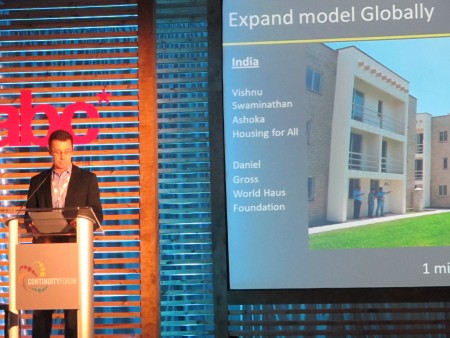
(Above: Francesco Piazzesi showcases hopes for Echale a tu Case at abc Continuity Forum).
But instead of simply urging more environmental conservation, Goodall’s major message took a turn. Over the past few years, she said, she’d engaged with the people destroying the chimpanzees’ habitat, and found they were themselves abysmally poor. The destruction they’d wrought didn’t even sustain their families for a year before more habitat had to be destroyed to provide the most meager survival. She worried governments had no proactive public policies for urban growth or incentives for smart private real estate development planning to help this growing population have decent housing, communities, and nutrition. Left to their own devices, their unchecked sprawl was killing their chances for a good life, just as it was killing the forests, soil, and the chimpanzees.
This realization, she said, has changed her principal focus: Now over 80 percent of her time is spent traveling the world to raise awareness that all of us are interconnected in sustainable solutions to the most important problems plaguing us, and to urge public and private leaders that their efforts to save chimpanzee habitat must include significantly improving human habitats – so both could thrive.
In her talk that first morning, she cited the world’s population was 6.9 billion.
Day Two of the Forum
Many other experts echoed Goodall’s principal message: Human population growth was accelerating and sustainable solutions for our well-being – or the planet’s – were not keeping pace. In steady succession, presentations confirmed:
– Coincidentally on day two of the Forum, the seventh billion baby on earth was born.
– UN global population data predict by 2050, nine to ten billion people will inhabit earth, with about five to six billion of them in Asia and India.
– Climate change, hunger and violence already have pushed over 51 percent of all the world’s population off the land and into cities.
– The rate is accelerating: Slums around cities from now on will receive an average of 200,000 newcomers each day.
– The world will need to build the equivalent of a city of one million people in developing countries every five days.
– Today in developed countries 70 percent live in urban areas.
– By 2050, fully 90 percent of the world’s population will live in – or a maximum of a day’s drive from – a city.
There’s the direct connection between Goodall’s insights about the causes of chimpanzees’ habitat destruction and why those same causes also affect the quality of life, work, income, health, and nutrition of humans everywhere. It was no accident, then, that Mexico’s Piazzesi was a finalist at this event for his innovations in affordable housing. Urban sprawl and slum growth are happening all over the world, not just in Africa. Unless we find ways to build human shelters in communities that do not randomly convert outlying land to slums, that use new, affordable means to cook, heat, cool and bring light into their homes that don’t deforest, pollute or jeopardize their health, and which plan integral communities that address income generation, nutrition, education and health care, no master plan for quality survival – for chimpanzees or our own – will succeed for any length of time.
Our Affordable Housing Series
The ills and broken housing value chains that sparked the work reported in this NextBillion series are the proverbial tip of the iceberg. Never has it been so important to view the human habitat from a systems perspective – think ecology, or envision the IT metaphor of the interconnected and interactive neural systems in the brain, where many separate pathways communicate with and reciprocally affect each other. To transform the affordable housing sector, we cannot ignore the interactive matrices of social, economic, environmental and political inputs and impacts. If we do, we will not create affordable, profitable or sustainable solutions.
It is clear that past patterns of providing urban shelter cannot continue as government action, public policy or business as usual.
A new, integrated, cross-sector set of solutions – and an enabling environment that supports business, government and citizen sectors together to address the housing gap in collaborative and innovative ways – is what will empower each of those sectors to become the positive and successful changemakers of the future.
Innovation is Key
 The blog posts published here show that innovation is a powerful, positive economic force for change. Piazzesi’s pressure-produced building blocks made of earth (pictured right), Mario Flores’ inventive disaster relief shelters that become foundations for permanent housing, new kinds of microfinance products and services that for the first time make a “mortgage” or a “home equity loan” for improvements accessible to BoP populations – and many others are necessary.
The blog posts published here show that innovation is a powerful, positive economic force for change. Piazzesi’s pressure-produced building blocks made of earth (pictured right), Mario Flores’ inventive disaster relief shelters that become foundations for permanent housing, new kinds of microfinance products and services that for the first time make a “mortgage” or a “home equity loan” for improvements accessible to BoP populations – and many others are necessary.
Long-term planning and sufficient capital to finance affordable housing (either publicly or privately built) are critically important. New home developments no longer should be built far away from jobs or transportation, schools and other public services. The “whole” of affordable housing – water, sanitation systems, roads, electricity, schools, clinics, public transportation, parks, retail and service employment opportunities – is best built into an integrated package, with responsibility appropriately shared by municipal, private and consumer resources.
Necessary but Not Sufficient
For many of this series’ authors, each of these essential ingredients still is not as powerful as combining them for leveraged impact. For example, all agree that sufficient and competitive financing for BoP homes and improvements is absolutely essential. Bundling financing with housing support services increases the return on investment, as posts by Sadna Samaranayake, here and here, Steve Weir and Susana Rojas Williams here and here, and Rakhi Mehra and Marco Ferrario all demonstrate.
Similarly, André Albuquerque showed multiple environmental, income and community improvements following quick and successful land tenure negotiations. Ashoka’s Housing for All work in Brazil’s favelas demonstrated the value-added results of technical assistance and microfinance, when delivered together, to improve health and safety, and increased families’ incomes and savings. (See video below).
Overarching themes that cross frontiers
Without planning it, two major themes recurred over many of the posts:
One: All these individual and necessary innovations will not solve the affordable housing gap quickly enough to end its ill effects in our lifetime, nor even keep pace with the demographic rising tide of newcomers to cities.
A new frame is needed for looking at affordable housing obstacles and opportunities – one that shifts the focus from narrow to wide – from an individual stakeholder (of land, or building materials, toilets, roofs, electricity, mortgages, public assistance, citizen clients) to the cross-sector collaborations that include them all.
Independently, authors wrote that even as they continue to advocate and dedicate their resources to finding more innovative solutions – they need to be working together, across borders and across sectors, to create affordable housing “ecosystems” that will continue to grow the results of their work to proportions that both are large enough to make a large dent in the sector – i.e. large enough to create disruptive and system-changing patterns to take hold – and to sustain this momentum over time.
As Valeria Budinich wrote, this means using a new social-business framework, the Hybrid Value Chain (HVC), that brings diverse stakeholders together in relationships that make affordable housing development successful. From Ashoka’s HVC pilot applications in the affordable housing sector in Colombia, Brazil and India, the lessons learned are that when BoP citizens and their advocates are included in business planning and execution, together they actually increase the size of the market “pie” – with more appropriate products, distribution channels and marketing efforts, and with new allies to tackle old problems like land rights or purchase which have often scared off private real estate ventures to move forward.
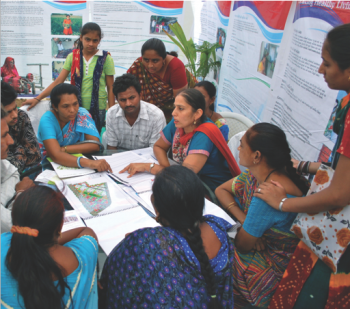
(Above: The first meeting of all stakeholders in Ashoka HFA India. Image credit: Rajendra Joshi for Ashoka.)
Budinich reports that HVC also ends up expanding the mindsets for both businesses (collaboration edging out competition as the framework for future long-term success) and for the citizen sector (mistrust of business exploiting the poor replaced by enabling citizens to participate as vital partners in market-driven opportunities). And indeed these new ways of looking at problem-solving through collaboration is one of the long-term, value-added benefits HVC frameworks provide, and a theme repeated in many posts in this series.
These “affordable housing ecosystems” include business pioneers such as Chip Reeves and his senior staff at Dow Corning; others at LaFarge, Holcim and Cemex, who invest in their people to innovate new building materials, develop new manufacturing processes to reduce their environmental footprint, and forge new, more inclusive collaborations between business, the social sector and the BoP client base to improve their product designs, marketing, costs, distribution and financing models.
Ecosystems also include public officials stepping up when standards and enforcement are needed, as in Martina Wengle’s post. Government officials also need to be mindful in their use of subsidies and incentives so that their spending supports – rather than undercuts – the private sector from robust entry and profits by providing housing for other segments of the pyramid’s needs (or the pyramid within the pyramid), as clearly articulated in the post by Vishnu Swaminathan.
Two: Communities and citizens themselves must be integral in the process of planning housing development, gathering market data, defining useful products and services, pricing and financing options – to ensure that business and/or government gets great innovation right.
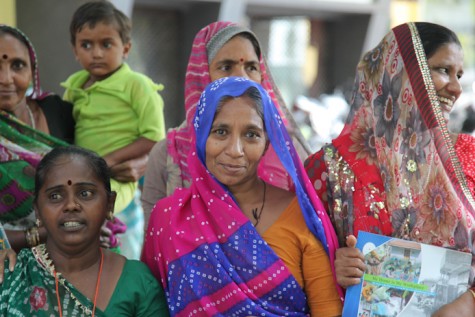
(Above : Saath clients after a workshop on new homes and financing with Ashoka HFA India. Image credit: John Michael Maas for Ashoka.)
As engineer Elizabeth Hausler concludes after years of developing detailed and precise ways to build earthquake or hurricane resistant housing, while technology and money are important, sharing knowledge with and learning from the people who will inhabit the homes is essential.
“People,” said Hausler, the founder of Build Change, “are the key to making these changes widely adopted, commonplace and continue over time. It is critical to motivate residents, builders, government officials and relief agencies to want to rebuilt correctly.” A lesson echoed in the majority of the posts from Brazil to India, Indonesia to Haiti.
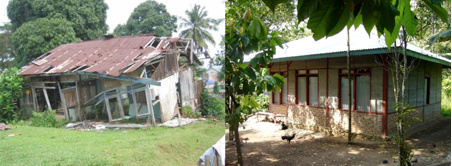
(A home damaged by earthquakes, rebuilt using Build Change techniques. Image credit: Build Change.)
Collaborations that Tear Down the Walls
The nature of these collaborations to build multi-stakeholder ecosystems is not static, nor should it be. Bill Drayton, founder of Ashoka, writes of the future resiliency and success of public and private sector ventures being built by “fluid teams of teams,” regrouping as needed to tackle specific problems and sharing knowledge and skills, and then joining other teams working on other challenges important to them. What is constant amid all this changemaking and motion is a new mindset for collaboration, one that leads to co-creation of value by all the stakeholders.
And it definitely includes tearing down the walls of silos of knowledge and talent, information and experience,and building bridges across divides between sectors of professionals, between business and citizens, between governments and the private sector, so that the power of their combined skills and knowledge unleashes untapped potential.
The Future?
We hope the posts published here served to inspire you to reach out to the authors, to experiment with and learn more about their solutions. We hope you will share your own successes and questions with Next Billion – in new posts or comments – to continue online to exchange ideas and opportunities in global collaborative entrepreneurship in affordable housing.
In the face of environmental destruction, Goodall said there were three major things that renewed her hope to continue her work:
1. evidence of the remarkable resilience of nature to rebound once the damaging actions stopped,
2. the transformational difference made by engaging communities to be co-creators of solutions, and
3. young people’s eagerness to learn and to innovate and see themselves as real changemakers who could make a difference.
The ideas that emerged from this series struck me similarly. It’s clear that we have the ingenuity and tools to close the gap in nobly built affordable housing in our lifetime. We lack only the political will to so do.
But this is changing due to our authors’ and other’s work locally and globally. Examples of collaborative and smart urban planning, successful increases in quality affordable housing that actually reduces cities’ environmental footprint, and visionary municipal-business-citizen partnerships that are boldly building vibrant cities of the future now showcase the results of integrated and innovative partnerships.
Although this series formally ends with this post – keep more examples of this coming! It is a local and global conversation we hope will help fuel reaching affordable housing for all in our lifetime.
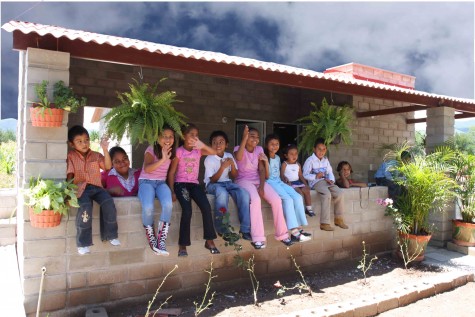
(Image credit: Echale a Tu Casa)
Editor’s note: Stay tuned in January for the release of an e-book compilation of this series’ posts, with new photos, videos and related information, published jointly by NextBillion and Ashoka, and free to distribute widely to and by all.
- Categories
- Investing, Uncategorized
- Tags
- housing
